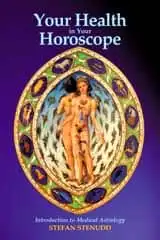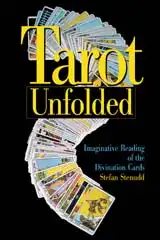|
TAROT
card meanings & free reading
|
The Devil
The Meaning of the Devil
|
|
The Tarot Devil is all about temptation and how we're often enslaved by our lust. There are many other devils, pointing to other vices and weaknesses of mankind. This one focuses on sexual aspects, which makes it much less frightening.
At the time of the production of this Tarot card deck, the beginning of the 20th century, lust was generally regarded as a sin, and sex was shameful — at least out of wedlock. Times have changed, though not completely and not everywhere. Still, modern society usually has a much brighter view on the sexual urges and their satisfaction than what the picture on the Tarot Devil card implies.
There are indeed many devils, in such a way that the ideas about what the devil signifies varies through time as well as from one congregation to another.
The fallen angel of the Old Testament usually tried to expose people as not being that very devoted to their god. Sin was to deviate from the path man was supposed to travel. When the praise of chastity grew in the monasteries and around them, as a way of remaining faithful to God, so did the condemnation of lust and sex. A good Christian was supposed to deny carnal instincts and become spiritual, almost as if leaving the body already in this life.
In such a world, the Tarot Devil would be the one tempting people to give in to their carnal desires. But there have been different views of the devil as well as of what is sin.
Goethe in his Faust made the devil a clever guy who revealed people's hypocrisy, thereby sort of doing God's work. Occultists in the early 20th century and onwards, such as Aleister Crowley of The Golden Dawn, saw the devil as a representation of the necessity to liberate oneself of inhibitions, in order to realize one's full potential as a human being. That devil was sort of a challenger.
In comparative religion, the devil is definitely what's called a trickster, a divinity acting as sort of a mediator between gods and men, often working for the benefit of the latter against the will of the former. A revolutionary of sorts.
As for the image of the devil, which we are quite familiar with, its inspiration is bound to come from Greek and Roman mythical creatures, such as Pan, the Fauns, and Satyrs. The horns are there, the goat legs too. Also, Pan and the others are notoriously lustful and uninhibited in the myths – the very opposite of what the Bible seems to preach.

Pan and Daphnis. Roman copy of a Hellenistic sculpture.
But back to the Devil portrayed on this Tarot card. He sits like a ruler of the enchained woman and man, who also have horns on their heads, albeit small ones. That makes them wilfully enchained — two persons giving in to their temptations.
The Tarot Devil card should be compared to that of the Lovers, who are guarded by an angel and who seem to remain in chastity. It's Eros against Agape — carnal love against spiritual. This Tarot deck condemns the former and praises the latter. But life would cease to exist without both.
So, the Tarot Devil is not necessarily a card about evil things happening. It's about temptation and satisfaction, lust and passion and boundless delight. It's about challenging one's limitations and inhibitions, daring to question established morals, revolting against prejudice.
The Devil Card as a Person
When the Tarot Devil card represents a person, it's somebody behaving in the above described devilish way — uninhibited and tempting. It's the kind of person you know you'd do best to stay far away from, but that's not easy.
The Devil Card as an Event
When the Devil card represents an event, it's an opportunity to let go of your inhibitions and satisfy your lusts, explore what you have not dared to before. Of course, as always with the Devil, there is a price. Be prepared to pay it, once you have followed your impulse. The Devil card asks the question: Do you dare to fall for temptation, and if not — do you have the strength to resist it?
The Devil Card as You
If the Tarot Devil card's position in the divination spread refers to you, it is because you have done away with many of your inhibitions and act upon your lusts and longings, even when others might be upset or even condemn it. You are sort of devilish — be it for long or just for the moment, depending on the position of the card and the question you might have asked in the divination. Well, have fun while it lasts. It should be invigorating.
A. E. Waite about the Tarot Devil Card
Click the header to read what A. E. Waite had to say about the Major Arcana Devil Tarot card symbolism and meaning in divination.
The Major Arcana Tarot Cards
- The Magician
- The High Priestess
- The Empress
- The Emperor
- The Hierophant
- The Lovers
- The Chariot
- Strength
- The Hermit
- Wheel of Fortune
- Justice
- The Hanged Man
- Death
- Temperance
- The Devil
- The Tower
- The Star
- The Moon
- The Sun
- Judgement
- The World
- The Fool
About Cookies
|
|
My Other Websites:
I Ching Online
The 64 hexagrams of the Chinese classic I Ching and what they mean in divination. Free online reading.
Complete Horoscope
How predictions are done in classical astrology with the full horoscope chart. Many examples.
Creation Myths
Creation stories from around the world, and the ancient beliefs about the world and the gods as revealed by the myths.
Other Books of Mine
Click the image to see the book (and Kindle ebook) at Amazon (paid link).

Your Health in Your Horoscope
What the horoscope says about your health, according to the old tradition of medical astrology.

Life Energy Encyclopedia
Qi, prana, spirit, pneuma, and many other life forces around the world explained and compared.

Archetypes of Mythology
Jungian theories on myth and religion examined, from Carl G. Jung to Jordan B. Peterson.
 Stefan Stenudd
Stefan Stenudd
About me
I'm a Swedish author. In addition to fiction, I've written books about the Tarot, Taoism, astrology and other metaphysical traditions. I'm also an historian of ideas, researching ancient mythology. Click the image to get to my personal website.Contact
 Tarot Unfolded
Tarot Unfolded